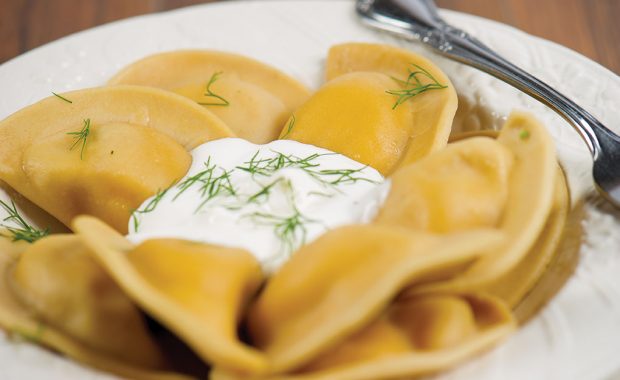KATRINA BOGUSKI
Staff Reporter
WILNO – National Pierogi Day, celebrated October 8, is a reminder that some things are still right with the world, and even those things which are difficult to bear can be made more tolerable by consuming a plateful of this time-honoured comfort food.
Pierogis, also known as vareniki, pedaheh, and other names, are staples of Poland, Ukraine, Russia, Slovenia and other European countries. A variety of spellings will be used in this article because some of the terms refer to specific brands or trademarks. Regardless of what you call them, pierogis have become part of Canadian culture thanks mostly to the influence of the Polish and Ukrainians who settled in various parts of Canada.
While Wilno boasts Canada’s first Polish settlement, prairie provinces such as Manitoba and Saskatchewan welcomed many large waves of immigrants from Poland and Ukraine in the first part of the 20th century; their influence can still be felt on the broader culture of places like Winnipeg.
In a piece called Iconic Canadian Food: The History of the Pierogi, food blogger Gabby Peyton wrote, “There are many food writers who actually say pierogi could be our national food. It’s no wonder: Canada has the third largest Ukrainian population in the world after Russia and the Ukraine itself.”
Canadians are not the only folks eager to claim pierogis as their national dish. Travel Writer Jonny Blair from Northern Ireland spent time in Poland and wrote an article called 11 Kinds of Pierogi You Should Try in Poland. In it, Blair said, “Pierogi is to Poland what sushi is to Japan or pizza to Italy. Simply put, pierogi is Poland’s national dish and can be found in restaurants, cafés and the famous Bar Mlecznys (Milk Bars) all over the country. One pierog (pierogi is plural) is a small semi-circular ‘dumpling’ made of dough and filled with a range of delicious ingredients.”
Depending on how they are filled, pierogis can be served as an appetizer, a main dish or even dessert.
“Pierogi kościeleckie” are listed by the Ministry of Agriculture and Rural Development for the Republic of Poland as among the traditional foods that come from southern Poland. These pierogis are named after the mountain village of Kościelec.
The ministry website includes information about how this village became associated with pierogis. It says that in 1238, the Dominican friar St. Hyacinth visited the village. While he was there, crops were destroyed by a devastating hailstorm which effectively took out the area’s food supply. St. Hyacinth instructed the people to pray, and the following day the damaged grain was restored and the people made dumplings from it. They gave them to St. Hyacinth in gratitude for his intervention. A translation of the Polish on the Ministry of Agriculture says,
“From that moment on, Kościelec and its vicinity became famous for making dumplings, which became not only their pride, but most of all the basis of food. Almost all the ingredients needed to make the dumplings came from the farm’s resources. Flour from your own wheat, cheese from your own cows, kurdybanek [a type of plant] from your own garden and jam from your own pantry.”
An old-fashioned Polish expression, “Święty Jacku z pierogami!” (St. Hyacinth and his pierogi!) spoken in desperation is possibly derived from this legend or other similar ones which associate him with pierogis. The saint is also attributed with saving people from starvation during a Tartar invasion in 1241 by feeding the hungry with pierogis. Hyacinth is the patron saint of pierogis and is sometimes depicted holding them.
In Canada’s western provinces, many churches are held together financially through the sale of pierogis made by stalwart church ladies in parish basements. They are crafted by hand, packed into bags, frozen and sold for a tidy sum. In some places the sales are held monthly and constitute a significant amount of income for the parishes.
Pierogis are so popular in the west that some church locations, especially Ukrainian Catholic churches, even offer monthly sit-down pierogi dinners that (under normal conditions) attract hundreds of people. Besides providing steady cash flow to the parishes, the pierogi sales and dinners are a chance to connect with people in the community who may not attend Mass regularly. It can be hard to get teenagers to attend church some days, but inviting them to chow down on a plateful of pierogis usually doesn’t take much effort. Regardless of people’s ethnic and religious backgrounds, the dinners are a chance for families and neighbours to sit down and enjoy some hearty comfort food together.
If you are already an online subscriber, CLICK HERE to access your subscription and read the full story.
If you wish to subscribe online, CLICK HERE, or you can pick up a copy of the October 7 Valley Gazette for the complete story.
